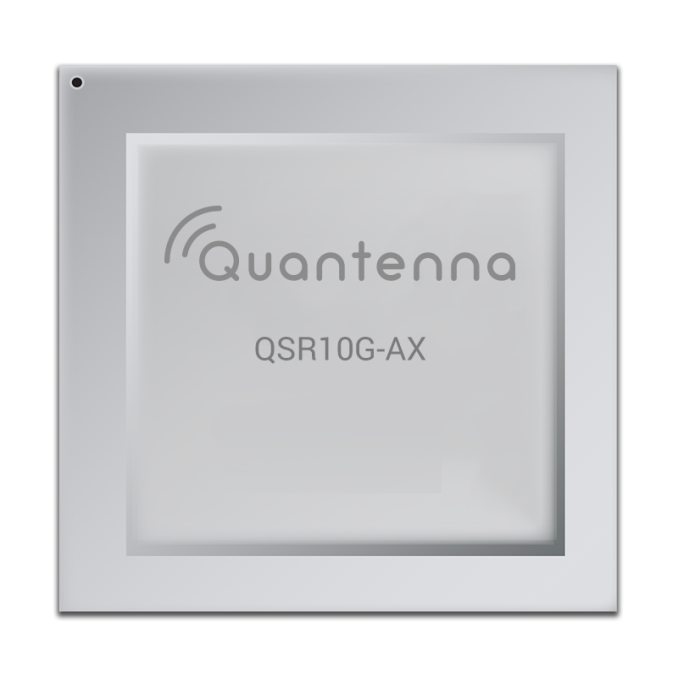Quantenna Announces 802.11ax Draft 1.0-Compliant Wi-Fi Chipset
by Anton Shilov on October 19, 2016 5:00 PM EST
Quantenna this week introduced the industry’s first 802.11ax Draft 1.0-compliant Wi-Fi chipset for access points. The QSR10G-AX is pin-to-pin compatible with Quantenna’s commercial QSR10G Wave 3 802.11ac-compliant Wi-Fi platform and can thus be easily integrated into existing APs (e.g., routers). The next-gen 802.11ax Wi-Fi standard promises to improve spectral efficiency of Wi-Fi operation in dense deployments and also to increase maximum theoretical bandwidth of Wi-Fi networks to around 10 Gbit/s.
Wi-Fi nowadays is a pervasive technology that is used by loads of different devices. Every office or residential building has tens of Wi-Fi APs visible and many people carry two or more of Wi-Fi-enabled devices with themselves (a smartphone, a laptop, most recently, smart watches). As a result, the number of connections that every AP needs to handle is getting higher every year, which requires higher spectral efficiency and more channels to connect devices. In the recent years the 802.11 standard introduced multiple ways to improve spectral efficiency of Wi-Fi, including multiple-input multiple-output antennas (MIMO), multi-user MIMO (MU-MIMO), higher order modulation and so on. The next-gen 802.11ax will add OFDMA (Orthogonal Frequency-Division Multiple Access) to allow different devices to be served by one channel, by dedicating different sub-carriers for individual client devices.
Quantenna’s QSR10G-AX is one of the industry's first 802.11ax Draft 1.0-compliant Wi-Fi chipsets, and supports the major features of the upcoming standard (including OFDMA, 1024-QAM and so on). Furthermore, to simplify deployment, it can be installed into existing designs due to pin-compatibility with the current QSR10G chipset. From a physical standpoint, devices based on the QSR10G-AX will use Quantenna’s 12-stream Wave 3 802.11ac dual-band Wi-Fi platform, which offers 8 streams in the 5 GHz band and a further 4 streams in the 2.4 GHz band. This essentially means that manufacturers using the QSR10G can simply throw in a more advanced chip and build an 802.11ax Draft 1.0-compliant router.
Right now, Quantenna does not specify the speeds that devices based on its QSR10G-AX will be able to provide, primarily because a lot will depend on actual client equipment. In the best case scenario with the currently available devices we are looking at 1733 and 2167 Mbps using four 802.11ac streams with 600, 800 and 1000 Mbps per stream. Nonetheless, keep in mind that the whole point of the 802.11ax is not to skyrocket maximum bandwidth (even though, maximum bandwidth remains important and does improve), but to ensure the ability to robustly serve the greatest number of clients using a single AP.
Meanwhile, the availability timeframe for such routers is unknown. Quantenna plans to make the QSR10G-AX chip available to its partners in early 2017. Then, it is going to take them some time to ensure that everything operates as planned (an uneasy thing to do due to lack of 802.11ax-compliant client equipment) and only then actual devices are set to hit the market.
Source: Quantenna











20 Comments
View All Comments
0ldman79 - Tuesday, October 25, 2016 - link
Feeding it will be an issue, but for massive wireless networks (WISP and such) the extra capacity will actually make it easier to feed proper speeds to the clients. We can get an 866Mbps connection to the client with AC now but once you have 20+ clients on there just the general traffic due to being connected starts to impact performance.BMNify - Thursday, October 20, 2016 - link
given that they are now in effect using many of the existing capabilities of DOCSIS 3.1 over wirelesssee http://www.incognito.com/blog/a-technical-guide-to...
"...the OFDM subcarriers can be bonded inside a block spectrum that could be as large as 192MHz which theoretically support 1.99Gbps. This has the added benefit of being able to leverage up to 10% efficiencies at the band edge on digital channel. Combining OFDM and multiple modulation profiles, channel bandwidths can be assigned to match exact real-time subscriber demand and/or channel conditions. Beyond the spectral efficiencies of OFDM with an LDPC FEC (COFDM) rather than mapping 6 or 8 bits to a symbol, the 4096-QAM maps 12 bits to each data subcarrier in the OFDM symbol...."
then we could be looking at the next standard to incorporate the benefits of both and so bring the costs down for real Gb+ consumer premises equipment 1024<>2048 QAM ranges.
Xajel - Thursday, October 20, 2016 - link
I really hope both 802.11ah and af becomes mainstream along with 10GBase-T...for those who hate those techy names...
802.11ah : a new sub-1GHz wifi ( 900MHz ) to have more range and penetration with lower power designed to extend the range of connected devices ( and keep them connected also) and helps IoT devices also save power...
802.11af : a high bandwidth based on 60GHz band, it will give much needed bandwidth at the expense of range and penetration, it's designed to offer enough bandwidth for demanded applications like multiple video streams ( specially 4K streams ), because it uses 60GHz so it has very low penetration and range.. so it's well suited inside a home theatre room or the living room, maybe hard for even two room penetration...
Impulses - Thursday, October 20, 2016 - link
802.11ah would be sweet in Puerto Rico... Concrete homes means even a modest 4 bedroom & 2 bath house needs two routers to cover the property due to poor wall penetrationCan't wait for all the af jokes tho...
Xajel - Monday, October 24, 2016 - link
You're not alone dude, we too have concrete homes, and as you said there's no single router solution... I need fast speed in the first floor but I only need internet access in the ground floor but I've already put a repeater in the ground floor and already planning on a second access point too in the ground floor.0ldman79 - Tuesday, October 25, 2016 - link
I've done WIFI for a hotel built like that. It is actually easier in some situations to have the AP outdoors and feeding the home through the windows.James5mith - Thursday, October 20, 2016 - link
Gigabit ethernet equipment has been more or less stagnant in price since the early 2000's. I bought a 16-port unmanaged gigabit switch back then for ~$100. Now it's ~$70. Why hasn't 10GbE been "mainstreamed" to push gigabit down to where 10/100 was 15 years ago?:sigh:
Perhaps I'll just use 40Gb IB instead. It's <1/3rd the price of 10GbE these days.
Pork@III - Thursday, October 20, 2016 - link
theoretically max 10gbps...practically 2-3gbpsMeteor2 - Thursday, October 20, 2016 - link
This article slightly misses the point. Ax is known as high efficiency wireless. It's designed for uses like providing wifi to sports stadiums, where there might be tens of thousands of devices connecting to hundreds of APs. It also has better range or propogation, and allows client devices to use slightly less power.Anato - Thursday, October 20, 2016 - link
After 802.11ag (~54Mbit/s) I stopped paying attention to this. That was and still is fast enough for most of the things I do over wifi. 802.11n brought 5GHz to masses which helps in congested. After that, MEHH, I'm old old-fashioned and cheap, I like copper and with good gear it delivers without hickups.